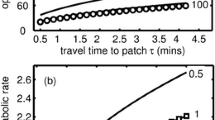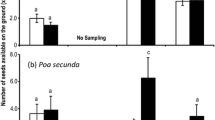Summary
Certain predictions of optimal- and central place-foraging theory were tested on the desert harvester ant, Pogonomyrmex californicus. Colonies were offered three different sizes of oat seed and found to maximize net energy intake (ei) over time (t i ) by harvesting the seed sizes with the highest e i /t i rank. Two aspects of t i were measured that were assumed constant in previous studies. The handling components of t i (time required to manipulate the seed and travel time back to the colony with the food) were measured and found to be positively correlated with seed size. The manipulation success rate (the percentage of handled seeds successfully picked up) decreased with increased seed size. These results point out how important it is to measure all parameters of e i /t i rather than to assume constancy with both prey type and foraging distance. The relative abundance of less preferred food types was important in determining the proportion of preferred types in the diet. The food supply of eight colonies was manipulated experimentally over a 25-day period. Four “deprived” colonies were constrained within aluminum enclosures to prevented foraging. The remaining four “satiated” colonies were given food ad libitum. The niche breadths of the treated colonies were then compared to controls, but found not to differ significantly. Seed baits were offered at three distances from the colony to test whether selectivity increased with disance. Contrary to theoretical predictions, all colonies harcested about the same proportion of each seed size at each distance.
Similar content being viewed by others
References
Charnov EL (1976) Optimal foraging: Attack strategy of a mantid. Am Nat 110:141–151
Davidson DW (1978) Experimental tests of the optimal diet in two social insects. Behav Ecol Sociobiol 4:35–41
Davis NB (1977) Prey selection and search strategy of the spotted flycatcher (Muscicapa strata): A field study on optimal foraging. Anim Behav 25:1016–1033
DeVita J (1979) Mechanisms of interference and foraging among colonies of the harvester ant Pogonomyrmex californicus in the Mojave desert. Ecology 60:729–737
Elner RW, Hughes RN (1978) Energy maximization in the diet of the shorecrab, Carcinus maenas (L). J Anim Ecol 47:103–116
Emlen JM (1966) The role of time and energy in food preference. Am Nat 102:385–389
Emlen JM (1968) Optimal choice in animals. Am Nat 100:611–617
Emlen JM, Emlen MJR (1975) Optimal choice in diet: test of a hypothesis. Am Nat 109:427–435
Estabrook GF, Dunham AE (1976) Optimal diet as a function of absolute abundance, relative abundance, and relative value of available prey. Am Nat 110:401–413
Freeland WJ, Janzen DH (1974) Strategies in herbivory by mammals — role of plant secondary compounds. Am Nat 108:269–289
Goss-Custard JD (1977a). Optimal foraging and the size selection of worms by redshank Tringa totanus. Anim Behav 25:10–29
Goss-Custard JD (1977b) The energetics of prey selection by redshank, Tringa totanus (L.), in relation to prey density. J Anim Ecol 46:1–19
Hughes RN (1979) Optimal diets under the energy maximization premise: the effects of recognition time and learning. Am Nat 113:209–221
Jenkins SH (1980) A size-distance relation in food selection by beavers. Ecology 61:740–746
Jorgensen CD, Porter SD (1982) Foraging behavior of Pogonomyrmex owyheei in southeast Idaho. Environm Entomol 11:381–384
Krebs JR (1978) Optimal foraging: decision rules for predators. In: Krebs JR, Davies NB (eds) Behavioral ecology: an evolutionary approach. Blackwell, Oxford, pp 23–63
Krebs JR, Erickson JT, Webber MI, Charnov EL (1977) Optimal prey selection in the Great Tit (Parus major). Anim Behav 25:30–38
Krebs JR, Stephens DW, Sutherland WJ (1983) Perspectives in optimal foraging. In: Brush AH, Clark GA (eds) Perspectives in ornithology. Cambridge University Press, Cambridge, pp 165–215
Lacher TE Jr, Willig MR, Mares MA (1982) Food preference as a function of resource abundance with multiple prey types: an experimental analysis of optimal foraging theory. Am Nat 120:297–316
Lessells GM, Stephens DW (1983) Central place foraging: single prey loaders again. Anim Behav 31:238–243
Levins R (1968) Evolution in changing environments. Princeton University Press, Princeton, NJ
MacArthur RH, Pianka ER (1966) On optimal use of a patchy environment. Am Nat 100:603–609
MacArthur RH (1972) Geographical ecology. Harper and Row, New York, NY
MacKay WP (1981) A comparison of nest phenologies of three species of Pogonomyrmex harvester ants (Hymenoptera: Formicidae). Psyche 88:25–74
Menge BA (1972) Foraging strategy of a starfish in relation to actual prey availability and environmental predictability. Ecol Monogr 42:25–50
Morse DH (1979) Prey capture by the crab spider Misumena calycina (Araneae: Thomisidae). Oecologia (Berlin) 39:309–319
Murdoch WW, Avery S, Smyth MEB (1975) Switching in predatory fish. Ecology 56:1094–1106
Orians GH, Pearson NE (1979) On the theory of central place foraging. In: Horn DJ, Stairs GR, Mitchell RD (eds) Analysis of ecological systems. Ohio State University Press, Columbus, OH, pp 155–177
Pulliam HR (1974) On the theory of optimal diets. Am Nat 108:59–74
Pyke GH (1984) Optimal foraging theory: A critical review. Ann Rev Ecol Syst 15:523–575
Pyke GR, Pulliam HR, Charnov EL (1977) Optimal foraging: a selective review of theory and tests. Q Rev Biol 52:137–154
Rapport DJ (1971) Optimization model of food selection. Am Nat 105:575–587
Rapport DJ, Turner JE (1977) Economic models in ecology. Science 195:367–373
Richards LJ (1983) Hunger and optimal diet. Am Nat 122:326–334
Rissing SW, Pollock GB (1984) Worker size variability and foraging efficiency in Veromessor pergandei (Hymenoptera: Formicidae). Behav Ecol Sociobiol 15:121–126
Rissing SW, Wheeler J (1976) Foraging responses of Veromessor pergandei to changes in seed production. Pan-Pac Entomol 52:63–72
Schoener TW (1971) Theory of feeding strategies. Ann Rev Ecol Syst 11:369–404
Schoener TW (1979) Generality of the size-distance relation in models of optimal feeding. Am Nat 114:902–914
Sih A (1979) Optimal diet: the relative importance of the parameters. Am Nat 113:460–463
Snyderman M (1983) Optimal prey selection: Partial selection, delay of reinforcement, and self control. Behav Anal Lett 3:131–147
Sokal R, Rholf J (1981) Biometry. Freeman, San Francisco, CA
Stamps J, Tanaka S, Krishman VV (1981) The relationship between selectivity and food abundance in a juvenile lizard. Ecology 62:1079–1092
Steel R, Torrie J (1960) Principles and produres in statistics. McGraw-Hill, New York, NY
Stein RA (1977) Selective predation, optimal foraging, and the predator-prey interaction between fish and crayfish. Ecology 58:1237–1253
Taylor F (1977) Foraging behavior of ants: experiments with two species of Myrmecine ants. Behav Ecol Sociobiol 2:147–167
Tinbergen J (1981) Foraging decisions in starlings (Sturnus vulgaris (L.). Ardea 69:1–67
Turner AK (1982) Optimal foraging by the swallow (Hirundo rustica, L.): prey size selection. Anim Behav 30:862–872
Waddington K, Holden L (1979) Optimal foraging: on flower selection on bees. Am Nat 144:179–196
Wallis DI (1964) The foraging behavior of the ant Formica fusca. Behaviour 23:150–176
Werner EE (1974) The fish size, prey size, handling time relation in several sunfish and some implications. J Fish Res Board Can 31:531–536
Werner EE, Hall DJ (1974) Optimal foraging and the size selection of prey by the Bluegill Sunfish (Leponis macrochirus). Ecology 55:1042–1052
Werner EE, Mittlebach GG, Hall DJ (1981) The role of foraging profitability and experience in habitat use by the bluegill sunfish. Ecology 62:116–125
Whitford WG (1976) Foraging behavior of Chihuahuan desert harvester ants. Am Midl Nat 95:455–458
Whitford WG (1978) Foraging in seed-harvester ants Pogonomyrmex spp. Ecology 59:185–189
Zach R, Falls JB (1978) Prey selection by captive ovenbirds (Aves: Pauridae). J Anim Ecol 47:929–943
Author information
Authors and Affiliations
Rights and permissions
About this article
Cite this article
Holder, K., Polis, G.A. Optimal and central-place foraging theory applied to a desert harvester ant, Pogonomyrmex californicus . Oecologia 72, 440–448 (1987). https://doi.org/10.1007/BF00377577
Received:
Issue Date:
DOI: https://doi.org/10.1007/BF00377577




